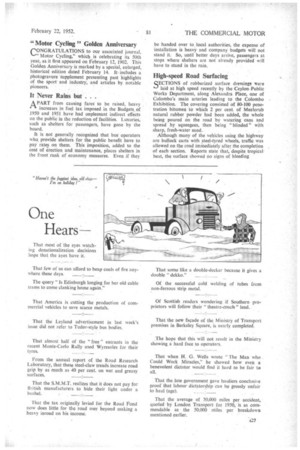One
Page 29

If you've noticed an error in this article please click here to report it so we can fix it.
Hears- That most of the eyes watching denationalization decisions hope that the ayes have it.
That few of us can afford to heap coals of fire anywhere these days, The query "Is Edinburgh longing for her old cable trams to come clanking home again."
That America is cutting the production of commercial vehicles to save scarce metals.
That the Leyland advertisement in last week's issue did not refer to Tudor-style bus bodies, That almost half of the " free " entrants in the recent Monte-Carlo Rally used Wyresoles for their tyres.
From the annual report of the Road Research Laboratory, that these steel-claw treads increase road grip by as much as 40 per cent, on wet and greasy surfaces.
That the S.M.M.T. realizes that it does not pay for British manufacturers to hide their light under a bushel.
That the tax originally levied for the Road Fluid now does little for the road user beyond making a heavy inroad on his income. That some like a double-decker because it gives a double "dekko," Of the successful cold welding of tubes from non-ferrous strip metal.
Of Scottish readers wondering if Southern proprietors will follow their "theatre-coach" lead.
That the new facade of the Ministry of Transport premises in Berkeley Square, is nearly completed.
The hope that this will not result in the Ministry showing a hard face to operators.
That when H. G. Wells wrote "The Man who Could Work Miracles," he showed how even a benevolent dictator would find it hard to be fair to all.
That the late government gave hauliers conclusive proof that labour dictatorship can bp grossly unfair to haul (age).
That the average of 30,000 miles per accident, quoted by London Transport for 1950, is as commendable as the 50,000 miles per breakdown mentioned earlier.




















































































